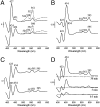Heme-copper terminal oxidase using both cytochrome c and ubiquinol as electron donors
- PMID: 22334648
- PMCID: PMC3295305
- DOI: 10.1073/pnas.1121040109
Heme-copper terminal oxidase using both cytochrome c and ubiquinol as electron donors
Abstract
The cytochrome c oxidase Cox2 has been purified from native membranes of the hyperthermophilic eubacterium Aquifex aeolicus. It is a cytochrome ba(3) oxidase belonging to the family B of the heme-copper containing terminal oxidases. It consists of three subunits, subunit I (CoxA2, 63.9 kDa), subunit II (CoxB2, 16.8 kDa), and an additional subunit IIa of 5.2 kDa. Surprisingly it is able to oxidize both reduced cytochrome c and ubiquinol in a cyanide sensitive manner. Cox2 is part of a respiratory chain supercomplex. This supercomplex contains the fully assembled cytochrome bc(1) complex and Cox2. Although direct ubiquinol oxidation by Cox2 conserves less energy than ubiquinol oxidation by the cytochrome bc(1) complex followed by cytochrome c oxidation by a cytochrome c oxidase, ubiquinol oxidation by Cox2 is of advantage when all ubiquinone would be completely reduced to ubiquinol, e.g., by the sulfidequinone oxidoreductase, because the cytochrome bc(1) complex requires the presence of ubiquinone to function according to the Q-cycle mechanism. In the case that all ubiquinone has been reduced to ubiquinol its reoxidation by Cox2 will enable the cytochrome bc(1) complex to resume working.
Conflict of interest statement
The authors declare no conflict of interest.
Figures





Similar articles
-
The Unusual Homodimer of a Heme-Copper Terminal Oxidase Allows Itself to Utilize Two Electron Donors.Angew Chem Int Ed Engl. 2021 Jun 7;60(24):13323-13330. doi: 10.1002/anie.202016785. Epub 2021 May 6. Angew Chem Int Ed Engl. 2021. PMID: 33665933 Free PMC article.
-
Identification of the ubiquinol-binding site in the cytochrome bo3-ubiquinol oxidase of Escherichia coli.J Biol Chem. 1994 Nov 18;269(46):28834-8. J Biol Chem. 1994. PMID: 7961841
-
Isolation of ubiquinol oxidase from Paracoccus denitrificans and resolution into cytochrome bc1 and cytochrome c-aa3 complexes.J Biol Chem. 1985 Feb 25;260(4):2458-67. J Biol Chem. 1985. PMID: 2982819
-
Structure, function, and assembly of heme centers in mitochondrial respiratory complexes.Biochim Biophys Acta. 2012 Sep;1823(9):1604-16. doi: 10.1016/j.bbamcr.2012.04.008. Epub 2012 Apr 24. Biochim Biophys Acta. 2012. PMID: 22554985 Free PMC article. Review.
-
Design and use of photoactive ruthenium complexes to study electron transfer within cytochrome bc1 and from cytochrome bc1 to cytochrome c.Biochim Biophys Acta. 2013 Nov-Dec;1827(11-12):1309-19. doi: 10.1016/j.bbabio.2012.09.002. Epub 2012 Sep 15. Biochim Biophys Acta. 2013. PMID: 22985600 Free PMC article. Review.
Cited by
-
A 3.3 Å-Resolution Structure of Hyperthermophilic Respiratory Complex III Reveals the Mechanism of Its Thermal Stability.Angew Chem Int Ed Engl. 2020 Jan 2;59(1):343-351. doi: 10.1002/anie.201911554. Epub 2019 Nov 28. Angew Chem Int Ed Engl. 2020. PMID: 31778296 Free PMC article.
-
The Unusual Homodimer of a Heme-Copper Terminal Oxidase Allows Itself to Utilize Two Electron Donors.Angew Chem Int Ed Engl. 2021 Jun 7;60(24):13323-13330. doi: 10.1002/anie.202016785. Epub 2021 May 6. Angew Chem Int Ed Engl. 2021. PMID: 33665933 Free PMC article.
-
Deciphering Staphylococcus aureus-host dynamics using dual activity-based protein profiling of ATP-interacting proteins.mSystems. 2024 May 16;9(5):e0017924. doi: 10.1128/msystems.00179-24. Epub 2024 Apr 24. mSystems. 2024. PMID: 38656122 Free PMC article.
-
Design of Heteronuclear Metalloenzymes.Methods Enzymol. 2016;580:501-37. doi: 10.1016/bs.mie.2016.05.050. Epub 2016 Jul 26. Methods Enzymol. 2016. PMID: 27586347 Free PMC article.
-
Verrucomicrobial methanotrophs: ecophysiology of metabolically versatile acidophiles.FEMS Microbiol Rev. 2021 Sep 8;45(5):fuab007. doi: 10.1093/femsre/fuab007. FEMS Microbiol Rev. 2021. PMID: 33524112 Free PMC article. Review.
References
-
- Saraste M. Oxidative phosphorylation at the fin de siecle. Science. 1999;283:1488–1493. - PubMed
-
- Pereira MM, Santana M, Teixeira M. A novel scenario for the evolution of haem-copper oxygen reductases. Biochim Biophys Acta. 2001;1505:185–208. - PubMed
-
- Iwata S, Ostermeier C, Ludwig B, Michel H. Structure at 2.8 Å resolution of cytochrome c oxidase from Paracoccus denitrificans. Nature. 1995;376:660–669. - PubMed
Publication types
MeSH terms
Substances
Associated data
- Actions
LinkOut - more resources
Full Text Sources
Research Materials

